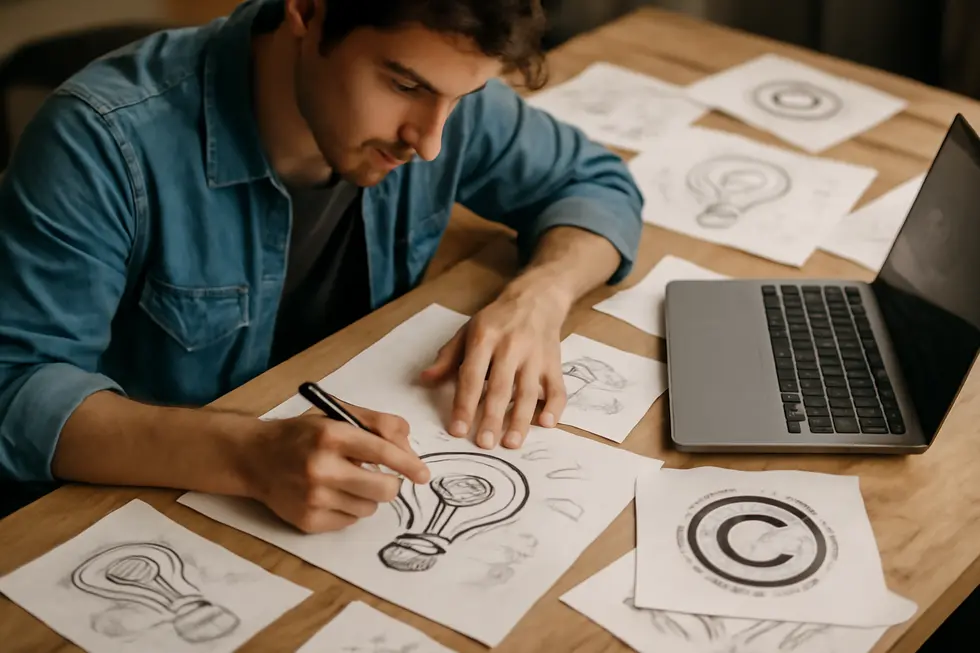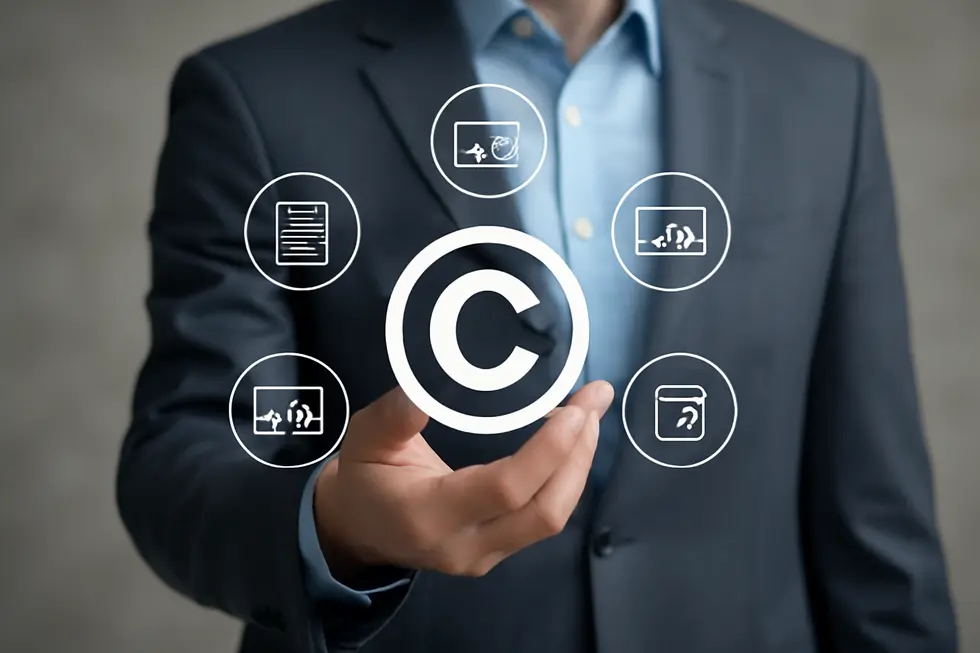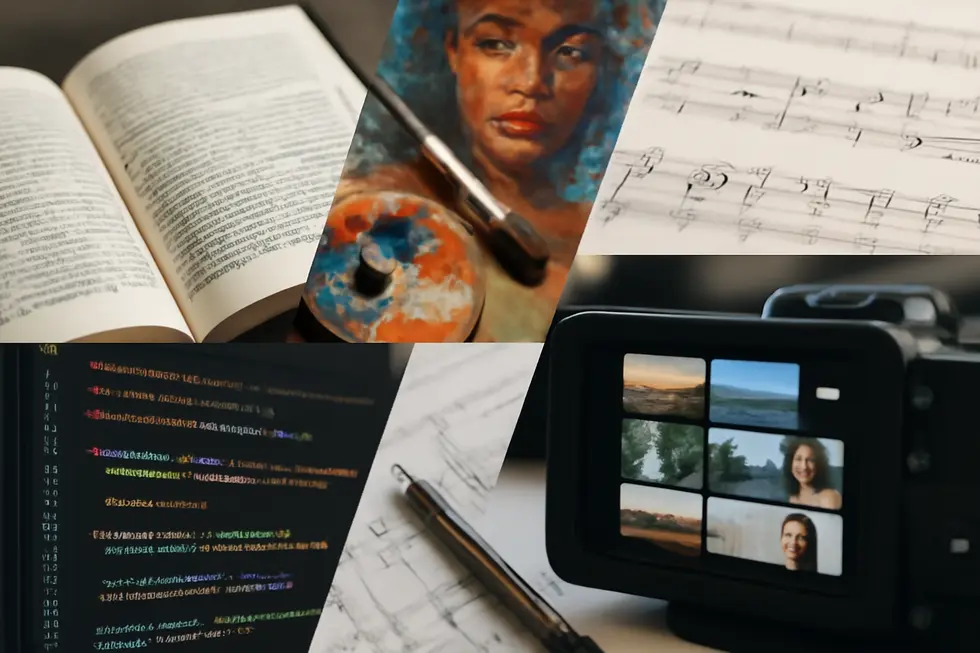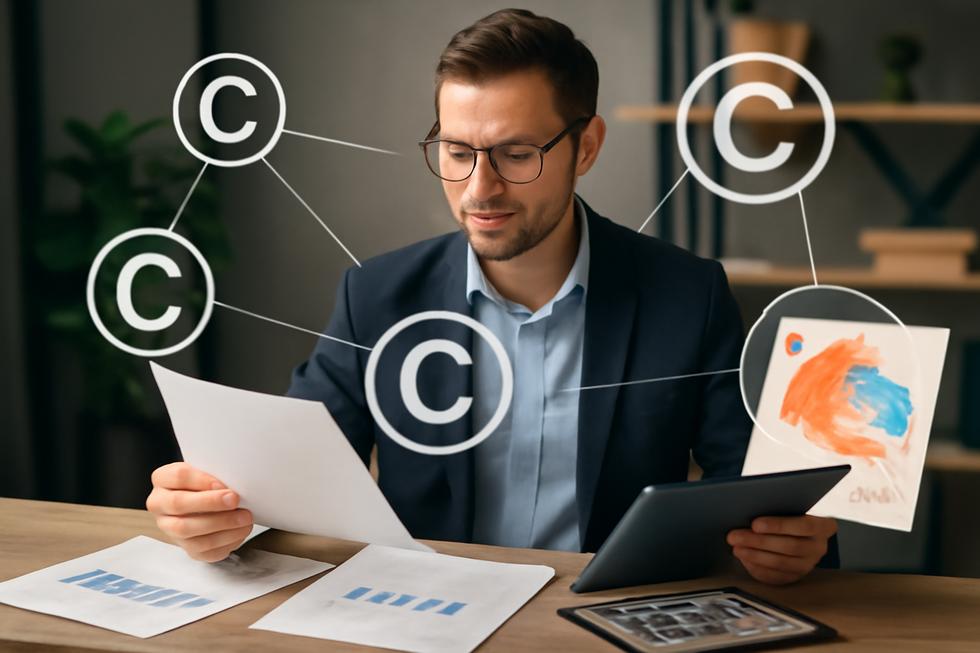Introduction
For business owners, protecting intellectual property is a critical step toward safeguarding innovation and competitive advantage. Copyright law provides a robust shield for original creative works, but understanding its foundation is crucial to leveraging this protection effectively. Copyright protection hinges on three pivotal elements: originality, authorship, and fixation. Grasping these core components not only clarifies which creations are eligible for protection but also informs how businesses can maximize their legal rights. Additionally, exclusive rights derived from copyright empower owners to control the use and distribution of their works, while various categories of protected works highlight the breadth of creations safeguarded by law. By examining these five essential elements, business owners gain informed insight into protecting their creative assets and fostering sustainable growth.
Tables of Contents
Chapter 1: Originality as a Fundamental Element of Copyright
- Tracing the Legal Roots and Doctrines Underpinning Originality in Copyright
- Navigating Originality in the Digital Age: AI and the Challenges to Copyright Authorship
- Originality’s Economic Power: Fueling Growth and Innovation in Creative Industries
- Global Influences and International Frameworks Shaping Originality in Copyright Law
- The Cultural Role of Originality in Shaping Copyright Protection
Chapter 2: Authorship Requirement in Elements of Copyright
- The Role of Human Creativity and Originality in Defining Copyright Authorship
- The Crucial Role of Fixation and Tangibility in Establishing Authorship
- Navigating Joint Authorship: Collaborative Creativity and Shared Copyright Ownership
- Understanding Works Made for Hire: Authorship and Employment in Copyright Ownership
- Creative Contributions and Authorship in Derivative Works
Chapter 3: Fixation in a Tangible Medium as an Element of Copyright
- How Fixation Defines Legal Protection by Transforming Ideas into Tangible Expression
- Navigating Fixation in the Digital Era: Technological Challenges to Copyright’s Tangibility Requirement
- Harnessing Economic Value through the Fixation Requirement in Copyright Law
- Global Perspectives on Fixation: How Geopolitics Shape Copyright Protection
- Cultural and Societal Dynamics Shaping Fixation in Copyright Protection
Chapter 4: Exclusive Rights Derived from Elements of Copyright
- The Essential Role of Originality in Establishing Copyright’s Exclusive Protections
- How Authorship Defines Ownership and Exclusive Rights in Copyright
- How the Fixation Requirement Unlocks Exclusive Copyright Protections
- Balancing Authority and Boundaries: Understanding the Flexibility of Copyright’s Exclusive Rights
- Navigating Licensing and Transfers: Legal Strategies and Economic Impact of Copyright’s Exclusive Rights
Chapter 5: Categories of Works Protected Under Elements of Copyright
- Exploring Literary Works: The Cornerstone of Copyright Protection
- Protecting Creative Expression: Musical and Dramatic Works in Copyright Law
- Exploring Visual and Audiovisual Creations: Copyright Protection for Artistic and Multimedia Works
- Distinctive Rights and Protection of Sound Recordings in Copyrighted Works
- Exploring Copyright Protection for Software and Architectural Designs
Chapter 1: Originality as a Fundamental Element of Copyright

1. Tracing the Legal Roots and Doctrines Underpinning Originality in Copyright
Originality is the cornerstone of copyright protection, firmly established through historical statutes and pivotal court decisions. Its legal roots trace back to early laws like the British Statute of Anne (1710) and the U.S. Constitution’s promotion of science and arts, embedding originality as a constitutional mandate. The landmark U.S. Supreme Court ruling in Feist Publications, Inc. v. Rural Telephone Service Co. (1991) decisively rejected protection based merely on effort, requiring a minimal degree of creativity—a “creative spark.” This ensures copyright safeguards an author’s independent intellectual creation rather than mere facts or compilations. Originality thus balances incentivizing creativity with public access to ideas and facts, defining the boundaries of legal protection. For a deeper discussion on copyright fundamentals, see copyright law and public domain.
[1] Feist Publications, Inc. v. Rural Telephone Service Co., 499 U.S. 340 (1991)
2. Navigating Originality in the Digital Age: AI and the Challenges to Copyright Authorship
The rise of digital technologies, especially artificial intelligence (AI), deeply challenges the traditional element of originality in copyright. Since copyright protection depends on human authorship and minimal creativity, AI-generated works disrupt this foundation by producing content with limited or no direct human input. This blurs ownership lines and complicates questions of infringement, as AI often relies on datasets containing copyrighted materials. Consequently, AI outputs may inadvertently resemble protected works, raising concerns over derivative works and liability. Platforms hosting such content face new risks and must adopt robust measures to detect infringements while clarifying content ownership through terms of service. These shifts prompt a reevaluation of copyright’s incentive framework, as AI enables massive content creation without traditional human creativity. Legal systems worldwide are still formulating responses to balance protecting creators, fostering innovation, and adapting to these technological advances, marking a pivotal moment in the definition of originality under copyright law. For an in-depth exploration of copyright protection basics, see copyright information for books. Further analysis of these evolving challenges is available at the LegalZoom resource on AI and copyright ownership.
3. Originality’s Economic Power: Fueling Growth and Innovation in Creative Industries
Originality stands at the heart of copyright’s economic influence, empowering creators to monetize their unique contributions. By granting exclusive rights, originality motivates continuous innovation, supporting jobs and cultural diversity in creative sectors. Far from saturating markets, advancements in technology often expand opportunities for original works to thrive alongside existing creations. This synergy sustains both legacy and new content, bolstering economic vitality. Recent legal decisions, such as significant settlements regarding AI training, reinforce the value of human creativity as a protected and remunerated asset. Yet, the rise of AI also challenges originality’s role by raising concerns over derivative content and potential threats to creative diversity. Recognizing originality as an economic catalyst ensures that creators retain incentives to produce authentic works. This balance underpins a sustainable creative economy where innovation and cultural richness prosper. For deeper insights on copyright’s economic role, see copyright definition economics business. External resource: Economic rationale of copyright and originality.
4. Global Influences and International Frameworks Shaping Originality in Copyright Law
Originality as a crucial element in copyright law reflects diverse interpretations shaped by geopolitical forces and international policy frameworks. While the core demand remains independent creation with creative expression, countries apply this standard within distinct legal and cultural contexts. International treaties, notably the Berne Convention, establish common baselines but respect national sovereignty, leading to nuanced differences in protection scope and enforcement. Power dynamics between major states, such as the United States and China, influence global intellectual property norms through their strategic focus on innovation and technology leadership. These geopolitical tensions affect international cooperation and cross-border licensing, which intertwine economic interests with political agendas. Societal values also modulate originality’s role, balancing creator rights with public goals like education and cultural access. This complex interplay embeds originality deeply within a global network of law, policy, and diplomacy, reflecting its pivotal role beyond purely legal definitions. For more insights on copyright characteristics, see characteristics of copyright.
5. The Cultural Role of Originality in Shaping Copyright Protection
Originality stands at the core of copyright, embodying the minimal creativity essential for legal protection. This requirement incentivizes creators by granting exclusive rights to their unique expressions, fostering a thriving cultural landscape enriched by literature, art, music, and innovation. Copyright recognizes the individual author’s effort and creativity, supporting both moral rights like attribution and economic interests such as control over commercial use. However, originality also balances the rights of creators with cultural heritage considerations. Collective traditions or folklore often lack the originality needed for copyright but carry significant societal value, emphasizing respect beyond legal frameworks. Thus, originality not only defines legal boundaries but also shapes cultural dynamics by encouraging innovation while honoring shared community expressions. For more insights into how originality influences copyright law and society, see this detailed analysis. Additionally, understanding originality’s role can aid creators navigating copyright information for books.
Chapter 2: Authorship Requirement in Elements of Copyright

1. The Role of Human Creativity and Originality in Defining Copyright Authorship
Central to copyright protection is the requirement that a work must embody human creativity and originality to qualify as authorship. This means a work must be independently created by a human and exhibit at least a minimal degree of creative input. Copyright law does not protect mere facts, ideas, or mechanical outputs, emphasizing that authorship arises only from genuine human intellectual effort. For example, images captured accidentally by animals or works generated solely by artificial intelligence lack the human creative spark needed for protection. Originality here demands independent creation rather than novelty, allowing even similar works to be protected if independently expressed. Additionally, such works must be fixed in a tangible medium, ensuring they can be perceived and reproduced over time. This framework safeguards true creative expressions while excluding unoriginal or non-human generated content, maintaining the integrity of the authorship element in copyright law. For further insight, the copyright information for books provides related guidance.
2. The Crucial Role of Fixation and Tangibility in Establishing Authorship
Fixation and tangibility serve as vital pillars in fulfilling the authorship element required for copyright protection. For a work to qualify, it must be an original creation fixed in a medium that endures beyond a fleeting moment. Fixation ensures the expression is captured in a stable form—such as writing, digital files, or recordings—allowing it to be perceived, reproduced, or communicated. This shifts the work from a mere concept to a concrete embodiment accessible to others.
Tangibility emphasizes that the medium itself must be perceivable, either directly or through devices, ranging from paper and canvas to electronic storage. These requirements ensure copyright protects actual expressions, not abstract ideas or transient thoughts. Critically, the fixation must arise through the author’s effort or authority and contain at least minimal creative input.
This framework, grounded in U.S. law (17 U.S.C. § 102), enables automatic protection upon creation without formal processes, favoring creators who transform ideas into tangible, reproducible works. For further insight, see the University of Memphis Copyright Basics guide.
For a deeper understanding of how fixation underpins authorship protection, explore resources on copyright law and public domain.
3. Navigating Joint Authorship: Collaborative Creativity and Shared Copyright Ownership
Joint authorship emerges when two or more human creators contribute independently copyrightable elements with the clear intent to merge their work into a single, unified expression. This intent is crucial, as courts consistently emphasize it as the defining feature distinguishing joint authorship. Each co-author holds an equal undivided ownership interest from inception, regardless of the extent of individual contributions. This equal ownership allows any joint author to grant non-exclusive licenses on their own, though exclusive rights transfers require unanimous consent. Collaborative works span diverse creative fields—from music and literature to visual arts and software—where teamwork produces integrated works. It is important to distinguish joint authorship from “work made for hire,” where an employer or commissioning party is legally recognized as the author under certain conditions, such as formal agreements or employment scope. Notably, only natural persons qualify as authors; while AI-assisted creations may be copyrightable, the human’s creative input must be significant. This nuanced dimension of authorship underscores the importance of intent and human creativity in sharing copyright interests. For further legal insight, see the University of Michigan Copyright Guide on joint authorship.
4. Understanding Works Made for Hire: Authorship and Employment in Copyright Ownership
Works made for hire embody a critical nuance within the authorship requirement of copyright law. When an employee creates a work within the scope of their employment, the employer automatically becomes the legal author, holding all copyright rights. This applies without needing a special contract, reflecting how contributions made during job duties are owned by the employing entity. For independent contractors, however, authorship transfers only if there’s a written agreement explicitly declaring the work as a “work made for hire.” This distinction ensures that copyright ownership aligns with control and investment, even if the actual creator is not recognized as the legal author. Understanding the employment scope and written agreement prerequisites clarifies who holds rights to reproduction, distribution, and derivative works—key exclusive copyrights. For more insights on copyright ownership in business contexts, see copyright information for books. Further details on this doctrine can be found at Cornell Law School’s Legal Information Institute.
5. Creative Contributions and Authorship in Derivative Works
Derivative works represent an important extension of the copyright framework, embodying new original authorship built upon existing protected creations. To qualify as copyrightable, a derivative work must display human creativity that adds novel expression to a preexisting work—such as a translation, adaptation, or revision. The authorship requirement mandates that this new contribution be independently created with at least minimal creative effort by a human author. Moreover, like all copyrighted works, derivative works must be fixed in a tangible medium that allows them to be perceived or reproduced. This ensures that copyright protects not only original creations but also creative transformations, granting copyright holders exclusive rights to authorize or create derivative works. This interconnectedness between authorship and derivative creations underscores the vital role of human originality within copyright law. For further details, see Indiana University’s comprehensive Copyright Guide.
Chapter 3: Fixation in a Tangible Medium as an Element of Copyright

1. How Fixation Defines Legal Protection by Transforming Ideas into Tangible Expression
Fixation in a tangible medium is a legal cornerstone that transforms intangible ideas into copyright-protected works. Under U.S. law (17 U.S.C. § 102), a work must be captured in a stable or sufficiently permanent form—such as written text, recorded audio, or saved digital files—to qualify for protection. This requirement distinguishes mere ideas or fleeting performances from fixed expressions, which are eligible for exclusive rights like reproduction and distribution. Copyright automatically vests the moment a work is fixed, granting creators legal grounds for enforcement without needing registration. Fixation also provides clarity by making the work objectively perceivable or reproducible, essential for identifying infringement. This principle maintains the balance between protecting original expression while keeping ideas accessible to the public. For a deeper understanding of how fixation fits within copyright elements, see the University of Michigan Library Copyright Basics.*
2. Navigating Fixation in the Digital Era: Technological Challenges to Copyright’s Tangibility Requirement
Fixation in copyright law traditionally demands a work be embodied in a tangible medium, such as paper or film. However, digital technologies have disrupted this principle by producing content that often lacks a clear physical form. Digital files, streaming, and cloud storage create works immediately accessible worldwide yet intangible in classic senses, complicating proof of fixation and ownership. Moreover, artificial intelligence challenges the human-authorship link, generating works from data without traditional creative intent, while brain-computer interfaces further erode the boundary between ideas and expression. Legal disputes, like Bartz v Anthropic, highlight how courts wrestle with digital fixation nuances amid fair use claims for AI training. Even software exemplifies this shift, as source code exists digitally but requires robust licensing and protection strategies. Similarly, performing arts such as dance struggle to meet fixation standards due to their ephemeral nature. The evolving technological landscape demands reconsideration of fixation’s scope to ensure copyright accommodates modern creative processes without sacrificing foundational protections. For a deeper exploration, consult this resource on copyright information for books and further legal analysis at https://asimovlaw.com/paper/
3. Harnessing Economic Value through the Fixation Requirement in Copyright Law
Fixation serves as the essential gateway to economic benefits in copyright protection. Without capturing a work in a tangible medium—whether via writing, recording, or digital storage—the creative effort remains intangible and unprotected under the law. This legal prerequisite enables creators to assert exclusive rights to reproduce, distribute, or license their work, directly translating creativity into monetizable assets. Fixation limits protection to the specific expression fixed, fueling market clarity and reducing disputes. It empowers rights holders to prevent unauthorized use that could erode revenue or market position, supporting enforcement actions that recover damages or impose injunctions. As a result, fixation not only safeguards artistic and intellectual output but also enhances the commercial value of portfolios vital for creative industries and technology businesses. This foundational element transforms ephemeral ideas into enforceable property, fostering investment and innovation. For a comprehensive perspective on how fixation grounds copyright protection and its economic stakes, see Louis Fireison Law’s detailed guide.
4. Global Perspectives on Fixation: How Geopolitics Shape Copyright Protection
Fixation, the embodiment of a work in a tangible medium, is essential for copyright protection worldwide but varies across geopolitical landscapes. Legal traditions such as common law and civil law influence how countries define and enforce fixation. For instance, the United States grants automatic protection upon fixation without formalities, reflecting its adherence to the Berne Convention principles. However, some nations require formal registration or have different thresholds for what qualifies as fixation. International treaties like the Berne Convention and TRIPS aim to harmonize these standards but still allow sovereign flexibility, resulting in variations shaped by cultural values, political priorities, and economic interests. These geopolitical dynamics not only affect how fixation is interpreted but also impact enforcement and cross-border recognition of copyrights. Understanding these distinctions is crucial for navigating the complex global framework protecting creative works. For more on copyright enforcement and fixation, see Trademark2Go’s overview on copyright fixation and enforcement. For additional context on international treaty frameworks, consult analyses of intellectual property enforcement strategies.
5. Cultural and Societal Dynamics Shaping Fixation in Copyright Protection
Fixation in a tangible medium is essential for copyright, yet its definition is deeply influenced by cultural and societal contexts. While the law demands that creative works be embodied in a physical form—such as text, recordings, or digital files—the kinds of media deemed acceptable vary with cultural values. For instance, artistic traditions rooted in specific societies may prioritize certain mediums, like oil painting or oral storytelling, affecting how works are fixed and recognized legally. Social expectations regarding creativity and authenticity also guide creators’ choices in how and whether to fix their works. The rise of digital technology further complicates fixation, blurring boundaries between tangible forms due to replication ease. Different cultures and legal systems respond uniquely, as attitudes toward ownership and sharing impact enforcement and protection. Thus, fixation is not purely a legal formality but a concept shaped by broader social and cultural influences, linking creative expression and tangible embodiment through varied lenses. For more insights, see copyright information for books.
Reference: Stephen McJohn’s comprehensive overview on fixation fundamentals provides valuable legal context.
Chapter 4: Exclusive Rights Derived from Elements of Copyright

1. The Essential Role of Originality in Establishing Copyright’s Exclusive Protections
Originality serves as the foundational element that unlocks the exclusive rights granted by copyright law. For a work to qualify, it must originate from a human creator and showcase a minimal creative spark beyond mere facts or ideas, which copyright does not protect. This originality requires two main aspects: independent creation without copying and the presence of some level of creativity, however slight. Without satisfying these, exclusive rights—such as reproduction, distribution, and derivative works—cannot be claimed. Additionally, originality strengthens the bond between the author and the work, closely linked with moral rights that protect attribution and integrity. Courts, like Mexico’s Supreme Court, emphasize the necessity of human authorship to establish originality, leaving AI-generated works outside copyright protection unless infused with human creativity. This vital element ensures copyright law safeguards the unique intellectual efforts fixed in tangible form, forming the legal basis for exclusive control. For a comprehensive analysis of this topic, refer to the University of Michigan Library’s guide on copyrightability.
2. How Authorship Defines Ownership and Exclusive Rights in Copyright
Authorship lies at the heart of copyright protection, determining who initially holds the exclusive rights granted by law. For a work to qualify, it must result from human creativity—simply put, an author must independently create an original work fixed in a tangible medium. This fixation ensures the work can be perceived or reproduced beyond a transient moment. Ownership typically vests with the author, who gains exclusive control over reproducing, distributing, publicly performing or displaying the work, and creating derivative works. Exceptions like joint authorship occur when multiple creators intentionally merge contributions, sharing ownership equally. Additionally, works made for hire shift authorship rights to employers or commissioners under specific conditions. These frameworks empower creators or their designated rightsholders to control the use and dissemination of their works. Understanding authorship is fundamental to grasping the scope and enforcement of copyright’s exclusive rights. For more on copyright’s exclusive rights and distribution control, refer to this detailed guide on copyright distribution rights. Further legal clarity can be found at Indiana University’s Copyright Guide on authorship and exclusive rights.
3. How the Fixation Requirement Unlocks Exclusive Copyright Protections
The fixation requirement is the essential starting point for copyright protection, mandating that a work be embodied in a tangible medium. This means that the expression of an original idea must be recorded in some physical or digital form—such as written text, an audio recording, or a digital file—capable of being perceived, reproduced, or communicated beyond a fleeting moment. Without fixation, creative works remain vulnerable and unprotected, as mere ideas or fleeting expressions do not attract exclusive rights.
Once a work meets the fixation criterion, a suite of exclusive rights automatically arises, empowering the author to control reproduction, distribution, public performance or display, and the creation of derivative works. These rights, established under U.S. law in 17 U.S.C. § 106, allow authors to monetize and manage their creations effectively. For instance, the right to distribute protects an author’s ability to decide how copies of a work circulate, while derivative rights guard adaptations and translations. Authors may license or transfer these rights, but until then, they retain full exclusive control.
Together, fixation and exclusive rights form a critical nexus that transforms creative expressions into legally protected assets, distinguishing protected works from mere ideas or ephemeral expressions. For further insight, consult the University of Michigan Library’s detailed Copyright Basics guide.
4. Balancing Authority and Boundaries: Understanding the Flexibility of Copyright’s Exclusive Rights
Exclusive rights granted by copyright empower the owner to control reproduction, distribution, public performance, display, and the creation of derivative works. These rights, outlined in Section 106 of the U.S. Copyright Act, allow authors to authorize or restrict others’ use. However, this authority is not without limits. The fair use doctrine permits certain unlicensed uses such as commentary, news reporting, and education, evaluating factors like purpose and market impact. Moreover, nonprofit educational exceptions enable use for instruction under specific conditions. Copyright protection also lasts for a finite term—typically the author’s life plus 70 years—after which works enter the public domain. Additionally, ideas, methods, and government works remain unprotected, confining rights strictly to original expressions. Licensing offers a practical mechanism for rights holders to transfer or share limited control while reserving key rights to safeguard their interests and encourage innovation. This dynamic balance ensures copyright exclusivity supports creativity without stifling legitimate use and progress. For further insights, review exclusive rights and distribution and consult Section 106 of the Copyright Act.
5. Navigating Licensing and Transfers: Legal Strategies and Economic Impact of Copyright’s Exclusive Rights
Exclusive rights under copyright empower creators with control over their original works, which can be strategically managed through licensing and transfer agreements. Licensing, especially exclusive licenses, permits the copyright owner to grant certain controlled uses to another party while retaining ownership, enabling monetization without surrendering full control. For example, an author might license publishing rights exclusively to a company while keeping other rights, such as film adaptations. By contrast, transferring copyright involves legally assigning ownership of specific rights to another party, granting them full authority to exploit those rights. Such transfers require written agreements detailing scope, duration, territory, and payment terms to avoid ambiguities. Economically, licensing provides creators with flexible revenue streams and segmented market access, while transfers often provide upfront payment in exchange for broader distribution but at the cost of future control. These legal frameworks balance creators’ interests with market demands, ensuring copyrights remain valuable assets. For further details on managing copyright rights under legal frameworks, see copyright distribution rights for business.
Chapter 5: Categories of Works Protected Under Elements of Copyright

1. Exploring Literary Works: The Cornerstone of Copyright Protection
Literary works form a central category under copyright law, protecting original expressions fixed in tangible form. This category extends beyond novels and poems to include non-fiction texts, articles, computer software, and databases—any authored work expressed in words or numbers. Protection hinges on two main criteria: originality, meaning independent creation with minimal creativity, and fixation, requiring the work to exist in a permanent or semi-permanent medium like paper or digital storage. Upon meeting these elements, copyright protection arises automatically, granting exclusive rights to reproduce, distribute, perform, display, and create derivative works. Duration typically spans the author’s life plus 70 years, or fixed terms for anonymous or work-for-hire creations. Literary works thus provide a broad yet well-defined foundation for safeguarding diverse authored content. For more details, see Indiana University Libraries’ copyright guide and explore comprehensive copyright information for books.
2. Protecting Creative Expression: Musical and Dramatic Works in Copyright Law
Musical and dramatic works represent vital creative categories safeguarded under copyright law once fixed in a tangible medium. Musical works include compositions such as songs and instrumental pieces, along with accompanying lyrics, protecting the underlying creation rather than sound recordings, which have separate protections. Similarly, dramatic works cover plays, scripts, stage performances, and choreographic elements when properly documented. Both types grant authors exclusive rights to reproduce, distribute, publicly perform or stage, display, and prepare derivative works. This legal framework ensures creators maintain control over the use and adaptation of their originals, securing economic benefits and artistic integrity. These protections arise automatically upon fixation without needing formal registration, emphasizing the law’s focus on original expression rather than ideas alone. For a deeper understanding of copyright rights and distribution, see copyright distribution rights in business. An authoritative resource on these foundational protections includes Copyright law principles related to musical works.
3. Exploring Visual and Audiovisual Creations: Copyright Protection for Artistic and Multimedia Works
Artistic and audiovisual works occupy a vital space within the categories of copyright protection, safeguarding the unique creative expressions embodied in visual and multimedia formats. These include artistic and pictorial works such as paintings, photographs, drawings, sculptures, and architectural plans—each requiring independent creation featuring at least minimal creativity. Simultaneously, audiovisual works encompass films, television shows, and online videos that combine moving images with sound, fixed in tangible media like film reels or digital files. Protection hinges on the work’s originality and fixation, ensuring the creator’s exclusive rights to reproduction, distribution, public display, and derivative uses. While copyright shields only the expression, not the underlying ideas, its coverage for these categories encourages cultural innovation and protects the creator’s investment. This balance supports continued artistic and multimedia creativity within the broader framework of copyright law. For more detail, see LegalZoom’s explanation on copyright protection.
4. Distinctive Rights and Protection of Sound Recordings in Copyrighted Works
Sound recordings hold a unique position as a category protected under copyright law, separate from the underlying musical composition. The law grants sound recording owners exclusive rights over reproduction, distribution, public digital performance, and creation of derivative works. Unlike musical compositions, which cover melody and lyrics, sound recordings refer to the specific fixed performance captured in a tangible medium such as digital files or vinyl. This distinction is critical because copyrights in the composition and the recording often belong to different parties. Since 1972, federal law protects sound recordings, while those created earlier rely on state common law. Traditional tunes may be public domain, but original arrangements or recordings with creative interpretation can gain copyright protection. The phonorecord copyright is symbolized by ℗, differentiating it from © used for compositions. These protections safeguard both the expressive fixation and commercial use of recordings, ensuring creators’ rights within this specialized category. For further details on sound recording protections, see Indiana University Libraries’ guide on Music Copyright and Licensing.
5. Exploring Copyright Protection for Software and Architectural Designs
Software and architectural designs stand as key examples within the categories protected by copyright, emphasizing the safeguarding of their unique expressions rather than the underlying ideas or functions. Copyright law protects the specific source code, object code, user interface designs, and structural frameworks inherent to software, as well as architectural plans and drawings fixed in a tangible medium. This protection arises automatically upon creation, granting exclusive rights to reproduce, distribute, and create derivative works of these expressions. While copyright covers the expressive aspects, patents may complement protection for innovative software architectures or novel user interface designs, provided they meet rigorous criteria like novelty and non-obviousness. However, patenting software user interfaces often faces challenges due to abstract idea exceptions. Ownership typically rests with the human author or employer if created within employment scope. This blend of protections ensures that both creative and functional features of software and architectural works receive appropriate legal recognition. For a deeper understanding of the nuances between copyright and patents in software, see Is Software Best Protected As A Patent Or A Copyright?. Additionally, explore detailed copyright guidance for software in copyright definition for computer works.
Final thoughts
Understanding the essential elements of copyright—originality, authorship, and fixation—empowers business owners to effectively protect their intellectual property. These foundational requirements determine eligibility for copyright protection and support the exclusive rights that help control and monetize creative works. By recognizing the broad categories of protectable works, businesses can strategically safeguard their innovations, from written content and software to visual designs and audiovisual productions. Mastery of these elements ensures your business innovations remain your competitive assets, legally shielded from unauthorized use and infringement. Taking informed steps to secure and assert copyright protections forms a vital part of your overall intellectual property strategy and business success.
Your IP is the foundation of your success – let’s protect it together before it’s too late. We can’t wait to help you turn your ideas into legally secured assets.
About us
undefined


